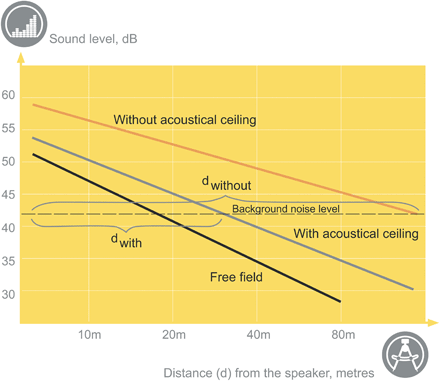Open-plan rooms
Open-plan rooms are an example of room design where the reverberation time must be supplemented with descriptors that are adapted to the room’s geometrical shape and that can provide guidance for the acoustical design. A central question regarding open-plan rooms is how the acoustic planning will affect the propagation of the sound in the premises and, thus, the acoustic comfort.
The main acoustic source of disturbance in an open-plan area is usually speech. It is therefore important that people who need to communicate sit near each other while, at the same time, different work groups must be sufficiently separated acoustically not to disturb each other.
The acoustic planning of an open-plan area requires that a number of factors should be taken into consideration, such as
-
location of work stations
-
choice of absorbent ceiling
-
design of furnishings (furniture, screens, wall absorbers)
-
silent work areas
-
floor surface
-
work methodology and technical aids
-
background noise
In order to achieve acceptable acoustic conditions in an open-plan area at all, a sound-absorbing ceiling is a necessity. The ceiling must have a high absorption factor and be installed at as low a level as possible to have the best possible acoustic effect.

The figure shows that the ceiling reduces the sound level and increases the rate at which the sound level decreases over distance. This also means that the distance required between work stations in order to achieve an acceptable level, i.e. a speech level that does not disturb or distract, will be shorter.
Characterisation of sound propagation
To characterise the sound’s propagation, there are descriptors that describe how much sound diminishes per doubling of distance. This descriptor that is designated DL2 and measured in dB states the gradient of the sound propagation curve. Another descriptor designated DLf and also measured in dB, states how the sound level at a certain distance behaves in relation to the sound level at the same distance in a free sound field, i.e. without reflecting objects. By increasing the DL2 value and simultaneously reducing the DLf value, the distance to the place where the sound level is no longer disturbing (distracting) will have decreased.
DL2DLf
Articulation class

In addition to reducing the sound level and increasing the reduction in sound level that occurs over distance, an absorbent ceiling will improve the function of screens and other screening furnishings. The degree to which a ceiling improves the effect of screens can be classified in an AC value (Articulation Class). The AC value is determined in accordance with ASTM E 1110 (2001). For an office ceiling, the AC value should be at least 180.
